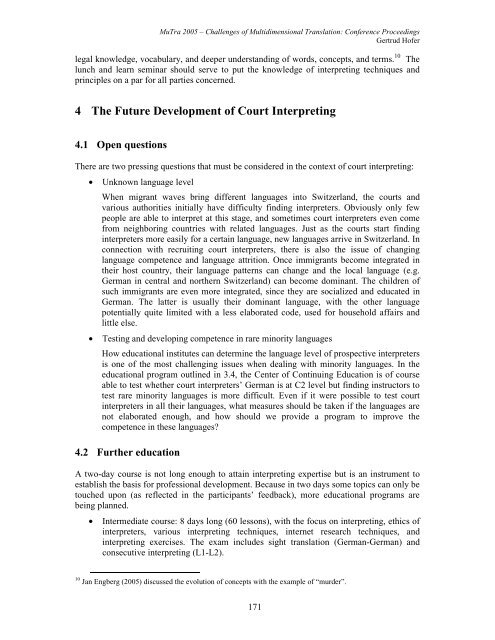Proceedings - Translation Concepts
Proceedings - Translation Concepts
Proceedings - Translation Concepts
You also want an ePaper? Increase the reach of your titles
YUMPU automatically turns print PDFs into web optimized ePapers that Google loves.
MuTra 2005 – Challenges of Multidimensional <strong>Translation</strong>: Conference <strong>Proceedings</strong><br />
Gertrud Hofer<br />
legal knowledge, vocabulary, and deeper understanding of words, concepts, and terms. 10 The<br />
lunch and learn seminar should serve to put the knowledge of interpreting techniques and<br />
principles on a par for all parties concerned.<br />
4 The Future Development of Court Interpreting<br />
4.1 Open questions<br />
There are two pressing questions that must be considered in the context of court interpreting:<br />
• Unknown language level<br />
When migrant waves bring different languages into Switzerland, the courts and<br />
various authorities initially have difficulty finding interpreters. Obviously only few<br />
people are able to interpret at this stage, and sometimes court interpreters even come<br />
from neighboring countries with related languages. Just as the courts start finding<br />
interpreters more easily for a certain language, new languages arrive in Switzerland. In<br />
connection with recruiting court interpreters, there is also the issue of changing<br />
language competence and language attrition. Once immigrants become integrated in<br />
their host country, their language patterns can change and the local language (e.g.<br />
German in central and northern Switzerland) can become dominant. The children of<br />
such immigrants are even more integrated, since they are socialized and educated in<br />
German. The latter is usually their dominant language, with the other language<br />
potentially quite limited with a less elaborated code, used for household affairs and<br />
little else.<br />
• Testing and developing competence in rare minority languages<br />
How educational institutes can determine the language level of prospective interpreters<br />
is one of the most challenging issues when dealing with minority languages. In the<br />
educational program outlined in 3.4, the Center of Continuing Education is of course<br />
able to test whether court interpreters’ German is at C2 level but finding instructors to<br />
test rare minority languages is more difficult. Even if it were possible to test court<br />
interpreters in all their languages, what measures should be taken if the languages are<br />
not elaborated enough, and how should we provide a program to improve the<br />
competence in these languages?<br />
4.2 Further education<br />
A two-day course is not long enough to attain interpreting expertise but is an instrument to<br />
establish the basis for professional development. Because in two days some topics can only be<br />
touched upon (as reflected in the participants’ feedback), more educational programs are<br />
being planned.<br />
• Intermediate course: 8 days long (60 lessons), with the focus on interpreting, ethics of<br />
interpreters, various interpreting techniques, internet research techniques, and<br />
interpreting exercises. The exam includes sight translation (German-German) and<br />
consecutive interpreting (L1-L2).<br />
10 Jan Engberg (2005) discussed the evolution of concepts with the example of “murder”.<br />
171
















